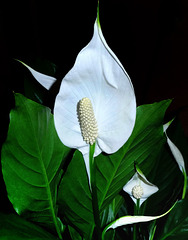Phil's photos with the keyword: Flower
"Happy Rose" Phalaenopsis orchid.
| 07 Mar 2020 |
|
|
|
Phalaenopsis orchid "Happy Rose" photographed using back-light (the sky) which gives a more accurate idea of the colours than my previous attempts using flash.
Camera: Nikon D500
Lens: AF Micro Nikkor 60mm f2.8
Processed with Nikon Capture NX2 and Pixlr Editor
Phalaenopsis orchid.
| 24 Aug 2018 |
|
|
|
Phalaenopsis (known as "Moth Orchids" and abbreviated "Phal" in the horticultural trade) is an orchid genus of approximately 60 species. Phalaenopsis is one of the most popular orchids in the trade through the development of many artificial hybrids. It is native to southern China, Taiwan, the Indian Subcontinent, Southeast Asia (Thailand, Philippines, Malaysia, Indonesia, etc.), New Guinea, the Bismarck Archipelago and Queensland.
(Wikipedia).
Camera: Sony RX100 compact.
Processed with NIkon Capture NX2.
"Happy Rose" phalaenopsis orchid.
| 17 Jun 2018 |
|
|
|
One of the easiest orchids to grow, Phalaenopsis (a.k.a. "Moth Orchid") is a small compact plant which has no "resting period" so it will often stay in flower all year round. Photographed with a Sony RX100 compact camera and processed with NIkon Capture NX2.
Orchidaceae.
| 13 Jul 2017 |
|
|
|
Wild flowers photographed in Raven's Clough Wood near Brierfield in North-West England. I'm not certain what these are....they appear to be members of the Orchidaceae family (Orchids), probably one of the "Marsh Orchids" (Dactylorhiza) which can be very variable in appearance and difficult to identify.
Camera: Sony RX100.
Processed with Nikon Capture NX2.
Spathiphyllum (a.k.a. "Peace lily"). Best viewed o…
| 01 Jul 2017 |
|
|
|
Spathiphyllum is a genus of about 40 species of monocotyledonous flowering plants in the family Araceae and are native to tropical regions of the Americas and southeastern Asia. Certain species of Spathiphyllum are commonly known as "Spath" or "Peace Lilies". They are evergreen herbaceous perennial plants with large leaves 12–65 cm (4.5-25.5 inches) long and 3–25 cm (1-10 inches) broad. Flowers are produced in a spadix surrounded by a 10–30 cm (4-12 inches) white, yellowish, or greenish spathe. The plant does not need large amounts of light or water to survive and several species are very popular indoor houseplants. It lives best in shade and needs little sunlight to thrive. The soil is best left moist and only needs watering if the soil is dry. The NASA Clean Air Study found that Spathiphyllum cleans indoor air of certain environmental contaminants, including benzene and formaldehyde.
(Wikipedia (edited)).
Busy Bee.
| 08 Jul 2014 |
|
|
|
Bees are flying insects closely related to wasps and ants and are known for their role in pollination and for producing honey and beeswax. There are nearly 20,000 known species of bees in seven to nine recognized families, though many are undescribed and the actual number is probably higher. They are found on every continent except Antarctica, in every habitat on the planet that contains insect-pollinated flowering plants. Bees are adapted for feeding on nectar and pollen, the former primarily as an energy source and the latter primarily for protein and other nutrients. Most pollen is used as food for larvae. Bees have a long proboscis (a complex "tongue") that enables them to obtain the nectar from flowers. They have antennae almost universally made up of 13 segments in males and 12 in females. Bees all have two pairs of wings, the hind pair being the smaller of the two; in a very few species, one sex or caste has relatively short wings that make flight difficult or impossible, but none are wingless. The best-known bee species is the European honey bee, which, as its name suggests, produces honey, as do a few other types of bee. Human management of this species is known as beekeeping or apiculture.
(Wikipedia).
Camera: Sony RX100. Processed with Nikon Capture NX2.
Ox-eye daisy.
| 26 Feb 2014 |
|
|
|
My very first photograph using a DSLR (Nikon D90 with the 18-105mm lens). Processed with Nikon Capture NX2.
Leucanthemum vulgare, the ox-eye daisy (syn. Chrysanthemum leucanthemum), is a widespread flowering plant native to Europe and the temperate regions of Asia and an introduced plant to North America, Australia and New Zealand. It is one of a number of Asteraceae family plants to be called a "daisy" and has the vernacular names: common daisy, dog daisy, moon daisy, and oxe-eye daisy.
Leucanthemum vulgare is a typical grassland perennial wildflower, growing in a variety of plant communities including meadows and fields, under scrub and open-canopy forests and in disturbed areas. Leucanthemum is from the Ancient Greek λευκός ("white") and ἄνθεμον ("flower").
(Wikipedia)
Jump to top
RSS feed- Phil's latest photos with "Flower" - Photos
- ipernity © 2007-2025
- Help & Contact
|
Club news
|
About ipernity
|
History |
ipernity Club & Prices |
Guide of good conduct
Donate | Group guidelines | Privacy policy | Terms of use | Statutes | In memoria -
Facebook
Twitter







